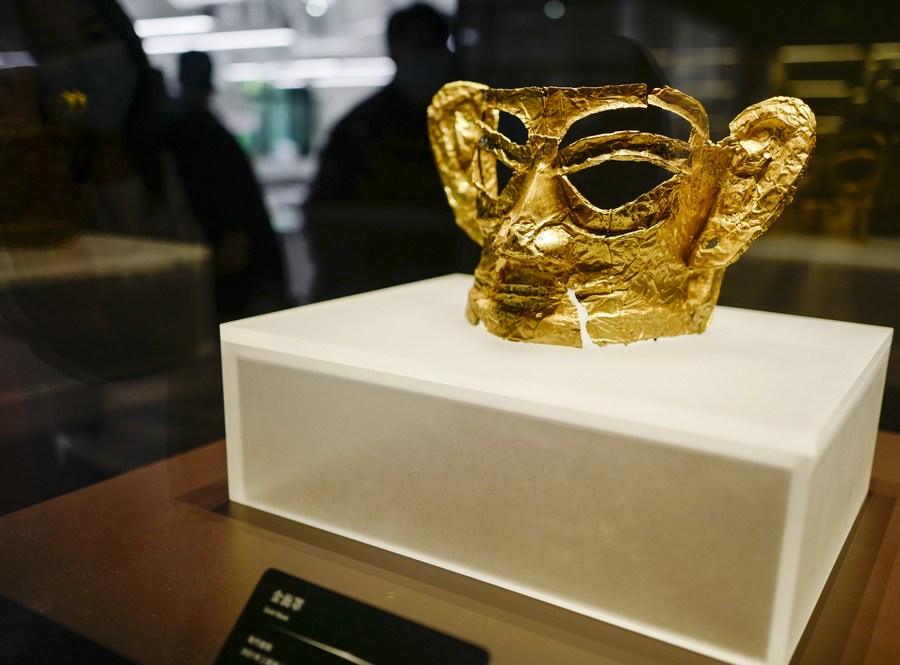Technologies bring China’s cultural relics back to life
China has integrated scientific and technological innovations with its cultural relics, restoring the glamour of these treasures and bringing them back to life.
An H5 page, a mobile function commonly used to promote events, of Sanxingdui Ruins site in southwest China's Sichuan Province, has been developed, which provides users with an immersive experience of the ancient Shu civilization. The H5 page includes special features, such as the sounds of the forests and the changing sunlight of the archaeological site, enabling users to experience the fun of archaeology.

Photo taken on Oct. 29, 2021 shows a golden mask on display at Sanxingdui Museum in Guanghan, southwest China's Sichuan Province.(Xinhua/Liu Chan)
This is made possible thanks to real-time rendering, according to Lu Yun, a senior expert of Alibaba Cloud, a top cloud service provider in China, and head of the H5 project team. “Real-time rendering can be used to build an online version of the vast number of archaeological sites and cultural relics to give the audience a better experience,” Lu added.
Likewise, smartphone users can easily enjoy the magnificent views of different sections of the Great Wall of China, as it stretches across many parts of the country, via a mini-program on WeChat, which offers a virtual tour of this wonder of the world.
Cui Xiaochun, vice president of Tencent interactive entertainment and head of the R&D team of the program, introduced that, though the digitalization of the Great Wall was proposed many years ago, the practice was confined to a very basic level, such as collecting and displaying images and three-dimensional models, and lacked more convenient and attractive digital experiences.
“With the support of photo-scan modeling technology, the team measured the Xifeng Pass of the Great Wall, in north China’s Hebei Province, with an accuracy of millimeter. After processing over 50,000 pieces of materials with real-time rendering, the team finally produced a hyper-real mode with over 1 billion facets,” said Cui.
Apart from offering an immersive experience of the Great Wall, the applet also includes interactive sections containing knowledge on the process of restoring the Great Wall, such as building techniques, cleaning and reinforcing of this masterpiece of construction of ancient China, Cui added.
Mogao Grottoes in Dunhuang, northwest China's Gansu Province, is among the first cultural institutions to start a digitization project in China. Since the 1980s, it has accumulated the data of over 280 caves, which has not only restored the glamour of Mogao Grottoes for good, but has also been widely applied to the studies of Dunhuang, archaeology and art of Mogao Grottoes, among other areas.
“The digital versions, which can be preserved permanently and replicated, meet the demands of preserving cultural relics,” said Liu Yuzhu, head of the China Foundation for Cultural Heritage Conservation. Liu added that the digital versions can be obtained immediately, which also facilitates the spread and promotion of the cultural relics.
An applet of Mogao Grottoes was launched by the Dunhuang Academy and Tencent in February 2020, when Mogao Grottoes temporarily closed due to the sudden outbreak of COVID-19. So far, 50 million users have used the applet, which is 19 times the number of in-person visitors Mogao Grottoes receives annually.
New technologies are expected to solve some long-standing problems of archaeology. For instance, broken pieces of cultural relics unearthed at archaeological sites, which usually come in large quantities, need to be identified and assembled. As it is difficult to finish the work efficiently and precisely using manpower alone, it will be a huge breakthrough of archaeology if digitalization can be applied to the work, said Zhao Hao, an associate professor at Peking University and head of the excavation of the No.8 pit at Sanxingdui Ruins site.
Photos
Related Stories
- Number of major historical and cultural sites protected at national level in China increases 115 percent over last decade
- Senior official urges enhanced protection of cultural relics, heritages
- "Taste" of cultural relics on the occasion of 110th anniversary of National Museum of China
- China calls for more efforts to protect revolutionary cultural relics
- China ensures safety of underwater cultural relics with technological means
- Precious cultural relics displayed in Chongqing
- Chinese museums enter metaverse to make better use of nation’s cultural relics
- Ruins of China's earliest state academy found in east China
- China to step up protection, utilization of grotto temples
- Tibet uses sci-tech mechanism for cultural relics protection
Copyright © 2022 People's Daily Online. All Rights Reserved.









